|
  |
|
Page 6 |
Newsletter 122, Autumn 2018 © Hampshire Mills Group |
|
City Mill, Winchester
Ruth Andrews
Pictures by Keith Andrews except as noted
|
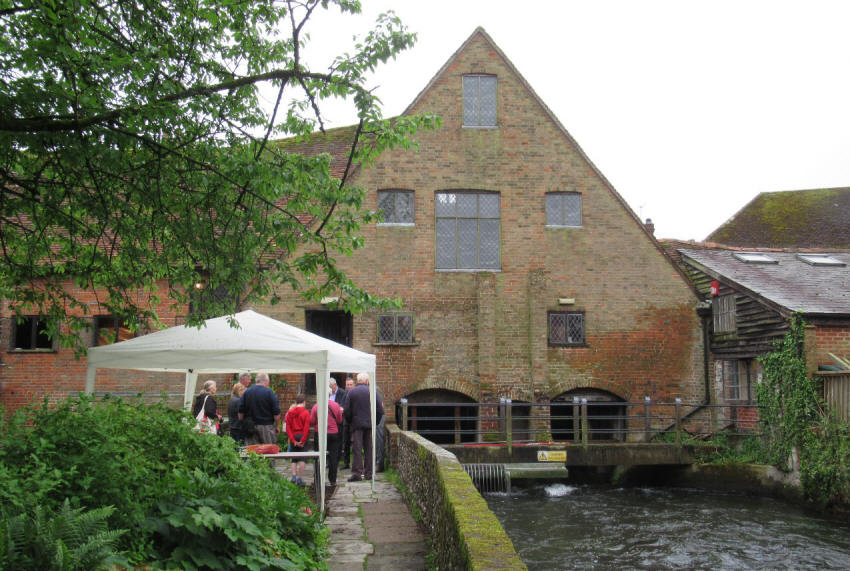
On 30 May 2018 a group of HMG
members were invited to Winchester City Mill by the
manager Ric Weeks to witness the restoration work
now in progress. He gave us an extremely
interesting tour which clearly demonstrated his
great enthusiasm for the building and its history.
First we gathered in the island
garden where Ric explained that the building is much
older and more complex than had been fully
understood in the 1920s when it was acquired by the
National Trust. Written references to a mill on
this site go back to the 10th century: for
instance, in 932 Eastgate Mill, as it was then
called, received an order of timber for the bishop.
By 989 Queen Elfrida had passed the mill to the
Benedictine nuns of Wherwell Abbey. It is thought
to be the oldest documented mill in the country, and
there are suspicions that it is even older still,
perhaps Roman.
|
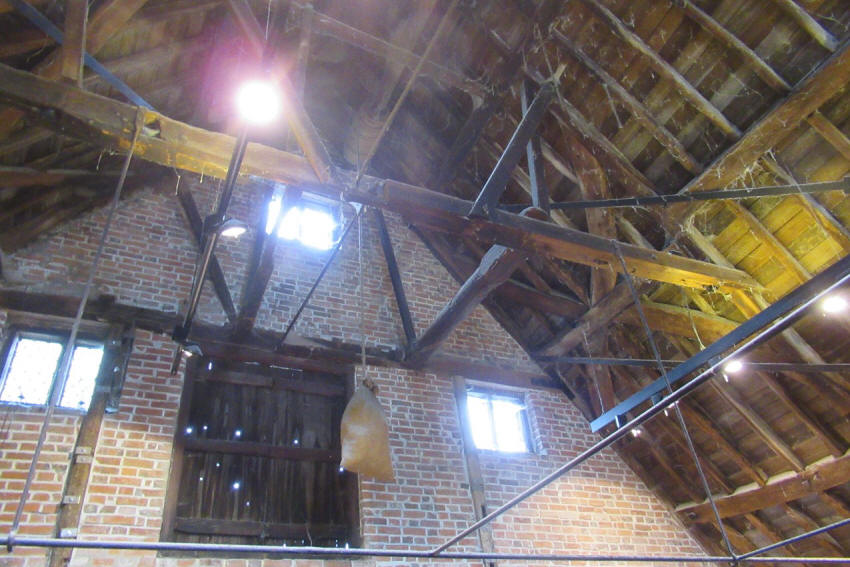
Although the mill was rebuilt in
the 1740s many of its timbers are a lot older. They
have now been dendrochronologically dated to the
11th century, and many were recut in the 14th and
15th centuries, making them less stout but more
refined; most Winchester roofs are much bulkier.
It is also of course possible that beams from
elsewhere were reused.
However, the 1744 rebuild
appears to have retained a lot of the older
structure. A small amount of wattle and daub
remains but it was largely replaced with imported
Flemish red bricks which now give the building the
air of a status symbol rather than a mill. It
seems likely that before the rebuild there were two
thatched buildings separated by a gap, as evidenced
by the different floorings in the basement. We also
looked at the roof beams (with quite a good display
of cobwebs) and the taking-in doors overlook the
downstream river. The doors are shown open in the
1795 JMW Turner sketch of the mill, which was found
by chance in 2013 by Ric when he was looking through
the Tate Archives.
We then walked round the road to
Water Lane where we split into 2 groups and donned
hard hats (there were only 7 of them) before
entering the basement. Here everything is still
supported by the Acroprops which have been
preventing the building from collapsing since it was
damaged by the floods in 2014.
|
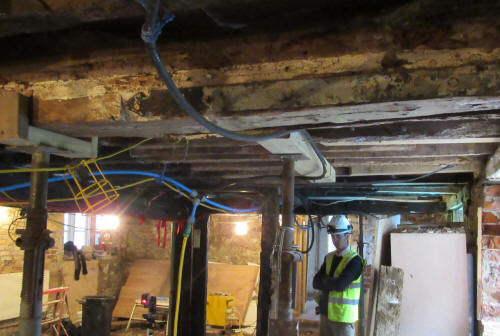 |
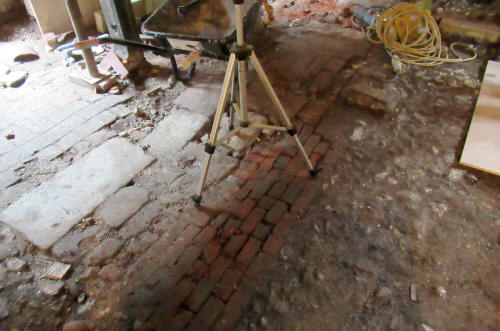 |
|
The workmen from Daedalus
Conservation who are doing the restoration work (in
conjunction with Donald Insall Associates, Historic
Building Consultants, and SFK Consulting, Civil
Structural and Environmental Engineers) allowed us
to examine their work. All the internal walls and
the unexpected asbestos panelling installed by the
YHA, who occupied part of the building from 1931 to
2005, have been removed (at a cost of around
£50000). The concrete floor has gone, revealing a
brick floor in the Water Lane end of the building,
compacted flints nearer the middle of the building,
and an earthen floor between the two. When the work
is finished this area will be used for offices and a
conference room.
We then walked back round to the
stones floor where the long-lost milling machinery
was replaced in 2004. Here public access is
currently limited to the area around the stones but
there is a viewing window which allows visitors to
see the ancient joists and the new additions. New
joists have been inserted parallel to the ancient
timbers and where necessary the rotten ends of the
old joists have been supported on metal hangers, so
the floor is once again self-supporting. To make
this possible 3 layers of flooring had to be
removed.
|

They dated from the mid-19th century, the late 18th
century, and the 1740 rebuild. Soon modern
floorboards will be installed and the whole of the
stones floor will be accessible once more.
We were asked if anyone knew who had constructed the
wooden model of the mill which is on display on this
floor (shown right), but we were not able to
supply a name. Can anyone reading this recall who
made it?
|
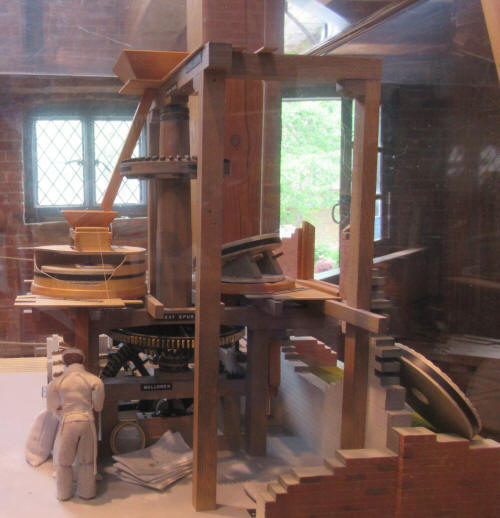 |
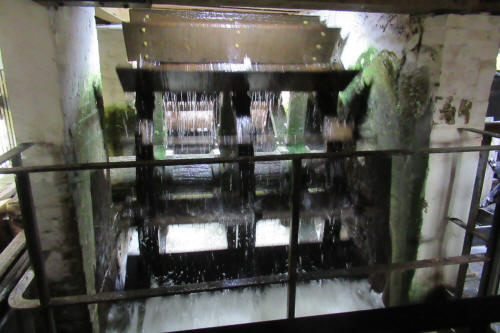 |
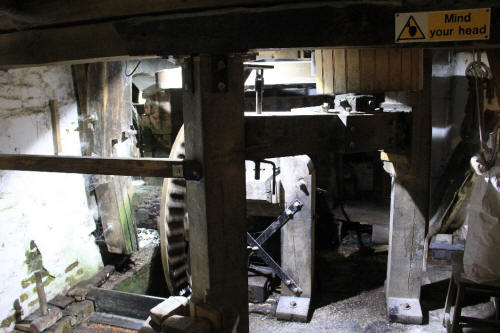 |
|
Finally we descended to view the current waterwheel
and associated milling machinery. Some of the old
timbers alongside the 21st century hurst frame have
also now been dated to the 11th century.
My thanks to Ivor New for arranging this visit, to
Ric Weeks for showing us round, and the National
Trust for allowing us access to the work area. Ric
is pictured here talking to one of our newer
members, Robin Appel.
|
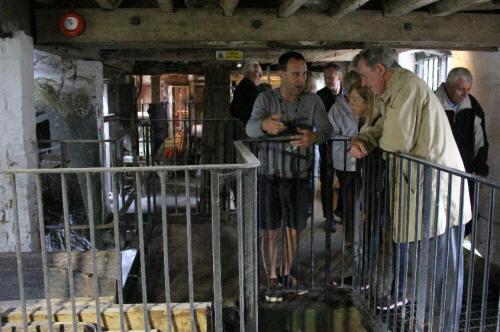 |
  |
|
|




